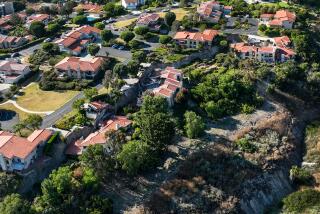Study Sees Design Issue in Failures of Levees
- Share via
A report issued Tuesday on levee failures in New Orleans during Hurricane Katrina lends further evidence that the system failed because of improper designs.
Two large breaches opened in the London Avenue levee because a gap emerged along the base of a concrete storm wall and allowed water to saturate sand in the foundation, investigators for the Army Corps of Engineers said.
Until now, investigators have focused mostly on the breaches along the 17th Street levee, even though the two breaches of storm walls on the London Avenue Canal were responsible for flooding much of the central city, including the hard-hit Gentilly neighborhood. A 410-foot-wide breach opened on the north end of the London Avenue levee and a 60-foot-wide breach opened at the south end.
“The soils at the floodwall area were weak and could not handle the forces that the water put on them,” a corps statement said.
The opening of a gap along the base of the storm wall was similar to the failure that occurred on the 17th Street Canal.
In this report, investigators backed off from a defensive posture that the corps lacked the research to have predicted such a failure. That was the assertion made in a March report on the 17th Street levee failure.
Just days after that report was issued, a team of investigators funded by the National Science Foundation issued a stinging rebuttal, saying the corps itself had conducted extensive tests of flood wall designs in the mid-1980s that had predicted the very sequence of events that occurred on the 17th Street Canal.
The tests included building a sample storm wall that tilted and opened up a gap when put under forces expected during a hurricane. The rebuttal showed the corps’ investigators had neglected to consult the organization’s own research.
The new report takes a more neutral approach, avoiding any assertions that the failure could not have been predicted.
Bob Bea, a UC Berkeley professor and civil engineer who is part of the National Science Foundation independent investigation team, said the London Avenue report contained the “right answers.”
Dave Daniel, president of the University of Texas at Dallas and head of an external review team that is watching the corps’ investigation, said he was satisfied so far with its progress.
Like the 17th Street Canal, the London Avenue Canal has a concrete storm wall that is perched on top of an earthen levee. As the water levels rose during Katrina and forces pushing against the wall increased, the wall tilted away from the canal and opened a gap along the base of the wall.
Water rushed into the gap and then saturated the sandy soil, particularly along the north breach. The instability created by wet sand ultimately caused the levee at the south breach to heave upward, the report said.
More to Read
Sign up for Essential California
The most important California stories and recommendations in your inbox every morning.
You may occasionally receive promotional content from the Los Angeles Times.














